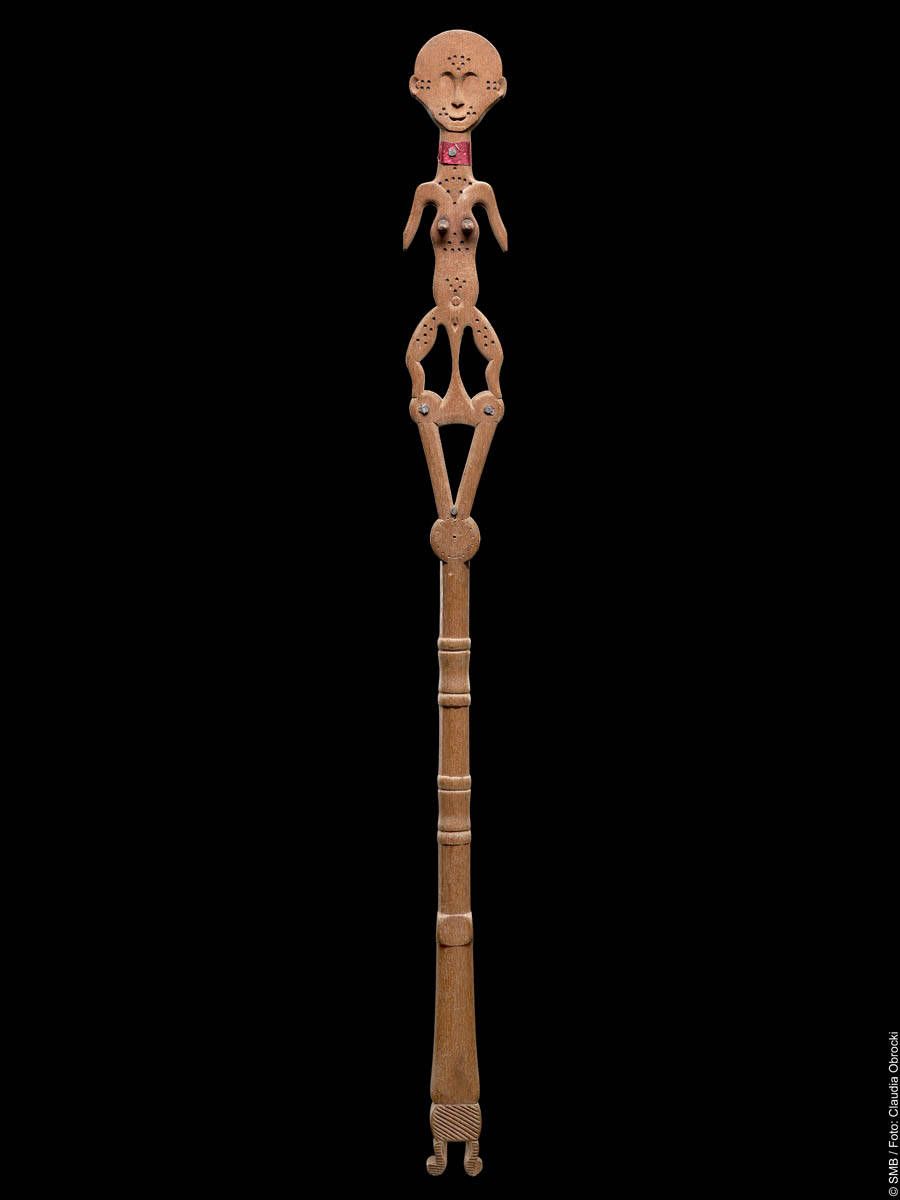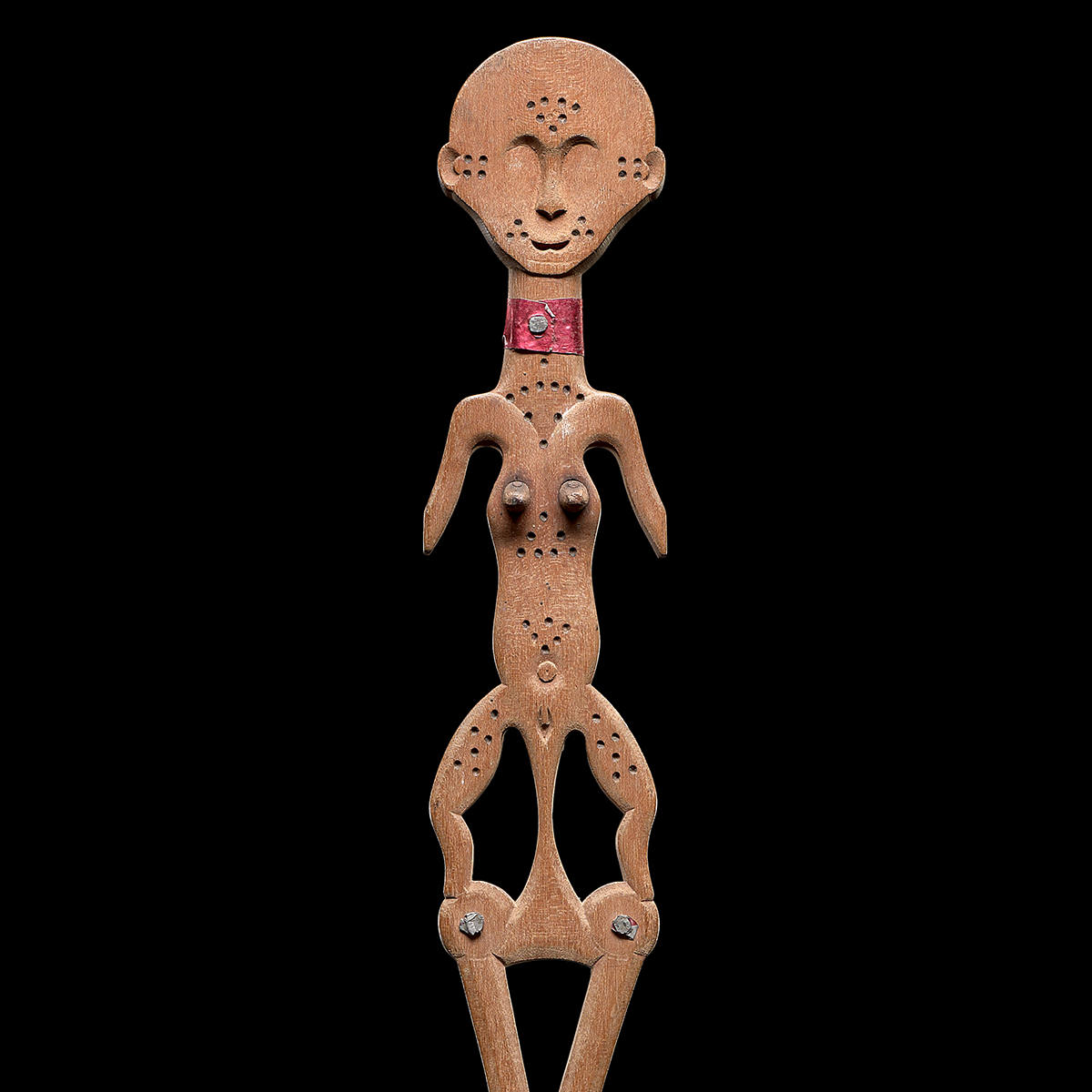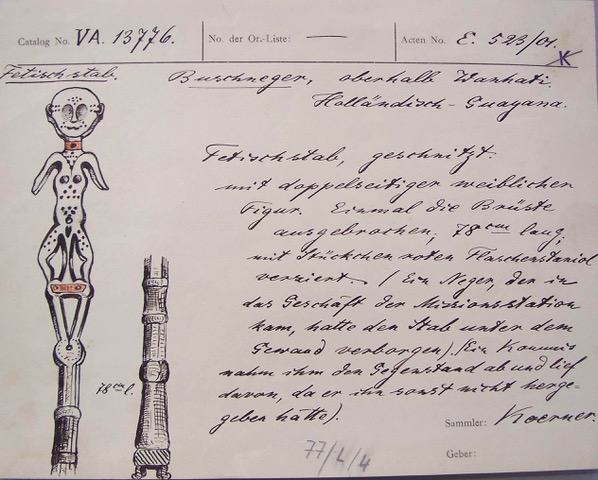Staff featuring a female figure
This staff is part of a group of Surinamese objects bought by the Ethnologisches Museum from the German collector Paul Körner in 1903. In the information provided alongside the purchase, the collector described the provenance of the staff: it was taken by an employee of the missionaries post of the Moravian Church, ‘as he would not have given it otherwise’.
The missionaries of the Moravian Church belonged to the Evangelical brotherhood, which was mainly active in Suriname. They immersed themselves in the languages and customs of the local population, but they also regularly ran plantations to fund their activities.
Because of their long-term ‘bond of trust’ and their regional networks, missionaries were suitable intermediaries for European museums that wished to establish ethnographic collections. Over the course of the 19th century, missionaries began to systematically collect objects for export. Many religious objects were acquired from converts or ‘heathens’, who were forced to part with them.
Originally, this staff belonged to the Maroon peoples (specifically, the Ndyuka people); a population descending from Africans who had fled slavery on the plantations to build an existence in the hinterlands of Suriname. It was looted during the period when Suriname was under Dutch colonial rule. The looting of cultural goods has lasting effects on the collective memory of the original owners regarding customs and traditions.
Jongsma + O’Neill made a documentary – which can be viewed on the monitor – with poet Onias Landveld, whose Ndyukan family has strong ties with the region from which the staff was looted.

Maroons
‘Maroons’ is a collective name for several ethnic groups in Suriname. The largest six are the Ndyuka, Saamaka, Aluku, Kwinti, Matawai and Paamaka. They are descended from former enslaved people who fled the plantations. To avoid being recaptured by the Dutch, the Maroons settled in Suriname’s inaccessible forests, where they lived side by side with the indigenous population. While the art, religions and customs of the Maroons reflect both African and indigenous influences and cultures, they also have qualities that are entirely their own.
Wood carving
Wood carving plays an important role in Maroon culture. In the mid-19th century, Maroon men began to decorate wood-carved benches, combs, stirrers, canoes and single-blade paddles with engravings and reliefs. While American and European researchers initially saw this as an authentic African art form, it is now clear that Maroon wood art has its own stylistic features. There are also major regional differences between Maroon communities in terms of their formal languages and craftsmanship. The Ndyuka, for example, tend to use more figurative motifs, such as lizards, snakes, birds and humans.
Staff
It has proved difficult to ascertain this staff’s significance to its original owners, as the information available is limited. Many Maroon artefacts have been stolen from their original owners, resulting in a significant loss of knowledge. To date, no similar staffs have been discovered that might provide more insight into the object’s history. However, after examination by several experts, it can be concluded that the staff’s stylistic features, such as the rough contours, are indicative of early wood carving styles. Also notable are the engraved dots on the face, stomach and legs of the female figure, which may represent scarification, a common form of body decoration among Maroon women.

Moravian Brethren in Wanhatti
In 1735, the first Moravian missionaries settled in Suriname with the aim of converting the population to Christianity. Between 1892 and 1907, they were active in the village of Wanhatti. While the Moravian Brethren took time to build up a relationship of trust with the local population, converting them proved rather difficult. In their annual reports, the missionaries recounted how they sometimes lost heart as the Ndyuka clung to their own rituals. Because ‘pagan idols’ were thought to stand in the way of the conversion, these were confiscated and collected by the Brethren. Sometimes the objects were taken by force, at other times narcotics were used.

Nuance
Convinced of their religious purpose, missionaries often did not see the confiscation of ritual objects as stealing. Today, opinions are divided on the conversion practices used by the Moravian Brethren. On the one hand, the systematic theft of art and other objects has led some people to perceive a loss of their cultural heritage. On the other hand, a significant part of today’s Christian Surinamese population has historical ties to this conversion history, and their perspectives on it are not inherently negative. The cultural encounters between missionaries and the people of Suriname were part of a complex social, colonial and political context.
